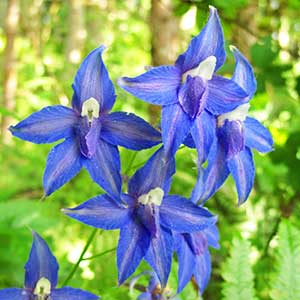Delphinium trolliifolium
Delphinium gypsophilum
Columbian larkspur, cow-poison, poison delphinium, poison larkspur
gypsum-loving larkspur, Pinoche Creek larkspur
(40-)60-120(-180) cm;
base usually reddish, glabrous to puberulent.
(30-)60-100(-150) cm;
base usually reddish, glabrous, glaucous.
blade ± pentagonal, 4-8 × 7-16 cm, margins ± incised, nearly glabrous; ultimate lobes 0-9, width 15-30 mm (basal), 5-20 mm (cauline), widest at middle or in proximal 1/2.
blade round to pentagonal, 1.5-6 × 2-12 cm, nearly glabrous; ultimate lobes 3-12, width 3-24 mm (basal), 1-8 mm (cauline).
(5-)14-40(-75)-flowered, ± open, at least 2 times longer than wide;
pedicel 1-4(-9) cm, puberulent to glabrous;
bracteoles (2-)6-12 mm from flowers, green, linear, 5-9(-14) mm, puberulent.
15-30(-64)-flowered, cylindric;
pedicel spreading, (0.5-)1.5-3.5 cm, glabrous;
bracteoles 2-6 mm from flowers, green, linear, 2-5 mm, glabrous.
sepals dark blue, glabrous, lateral sepals spreading, (8-)14-21 × 5-9 mm, spurs straight or downcurved at apex, within 20° of horizontal, (10-)16-23 mm;
lower petal blades covering stamens, 5-10 mm, clefts 1.5-3 mm;
hairs sparse, mostly near junction of blade and claw, centered or on inner lobes, well dispersed, yellow.
sepals rarely reflexed, white to pink, nearly glabrous, lateral sepals spreading, 7-19 × 3-10 mm, spurs straight to upcurved, ascending 30-45° above horizontal, 7-15 mm;
lower petal blades elevated, exposing stamens, 3-8 mm, clefts 1-4 mm;
hairs centered near base of cleft, ± evenly distributed, white.
(15-)23-34 mm, 3.8-5.5 times longer than wide, glabrous.
9-18 mm, 2.5-3.2 times longer than wide, puberulent.
unwinged;
seed coats smooth.
seed coat cells brick-shaped, cell margins undulate, surfaces roughened.
= 16.
Delphinium trolliifolium
Delphinium gypsophilum
Delphinium trolliifolium occurs in the northern Coast Range of California, the Columbia River Valley to just east of Mt. Hood, and the Willamette Valley of Oregon upstream to Lane County. California plants differ somewhat from Oregon plants in pubescence patterns and habitat preferences. Further study may show that two entities are involved here.
Hybrids between Delphinium trolliifolium and D. decorum, D. menziesii subsp. pallidum (D. ×pavonaceum Ewan, Peacock larkspur), D. nudicaule, D. nuttallianum, and D. nuttallii are known. Delphinium trolliifolium is likely to be confused only with D. bakeri. Refer to discussion under that species for differences.
(Discussion copyrighted by Flora of North America; reprinted with permission.)
Subspecies 2 (2 in the flora).
Delphinium gypsophilum is sometimes confused with D. hesperium subsp. pallescens, D. recurvatum, and the white-flowered phases of D. hansenii subsp. kernense. The echinate seeds and long-haired petioles of D. hansenii immediately distinguish it from D. gypsophilum, which has neither.
Delphinium gypsophilum is related, and similar in many respects, to D. recurvatum. The two may be distinguished morphologically by their sepals. Delphinium recurvatum has reflexed, blue sepals; those of D. gypsophilum are spreading and white, although they may change to light blue when dry. Plants of D. recurvatum normally are less than 60 cm; those of D. gypsophilum are usually more than 60 cm. Ecologically, D. recurvatum occupies level ground among shrubs, typically in alkaline valley bottoms; D. gypsophilum is found on well-drained hillsides among grasses and in chaparral and oak woodland.
From Delphinium hesperium subsp. pallescens, specimens of D. gypsophilum may be separated by their much more finely dissected leaves, with less surface area, stem base usually reddish, stems frequently glaucous proximally, undulate margins of seed coat cells, and absence of striations in stem base of dried specimens. In contrast, D. hesperium subsp. pallescens has leaves less dissected, with greater surface area, stem base rarely reddish, stem not glaucous proximally, seed coat cells with straight margins, and striations present on the proximal stem of dried specimens.
(Discussion copyrighted by Flora of North America; reprinted with permission.)
1. Lower petals 5–8 mm; lateral sepals 10 mm or more; pedicel usually more than 1 cm apart. | subsp. gypsophilum |
1. Lower petals 3–5 mm; lateral sepals 10 mm or less; pedicel usually less than 1 cm apart. | subsp. parviflorum |


